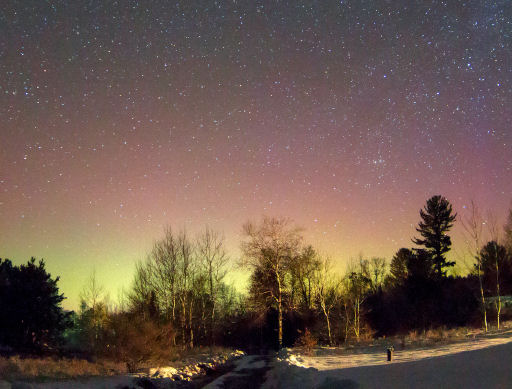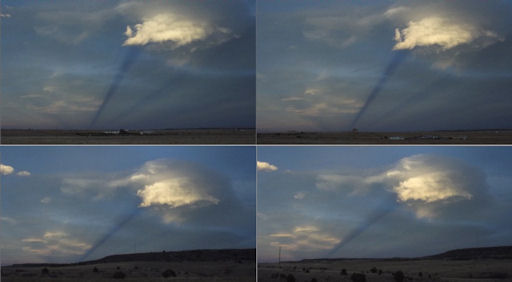When is the best time to see auroras? Where is the best place to go? And how do you photograph them? These questions and more are answered in a new book, Northern Lights - a Guide, by Pal Brekke & Fredrik Broms. | | |
DARK MATTER ON THE ISS: A particle detector on board the International Space Station has recorded intriguing signs of Dark Matter that could reveal what the mysterious substance is made of. If the finding holds up, it could lead to significant advances in cosmology. [full story] [video]
CME IMPACT: A coronal mass ejection (CME) hit Earth's magnetic field on April 13th. The impact was not a strong one; geomagnetic activity never crossed storm thresholds. Nevertheless, the impact sparked faint auroras photographed in several northern-tier US states. Brian Larmay sends this exposure from Beecher, Wisconsin:

"I got up at 230 am CST to see if the auroras had made their way south, and I saw a glow that looked to he naked eye like light pollution," says Larmay. "My camera revealed the colors. I didn't expect much of a display because the CME impact was rather weak--but there it was."
"I have noticed that the southern hemisphere of the sun is starting to pepper more with spots," he continues. Indeed, the southern hemisphere has been lagging behind the north in sunspot production, and it might be starting to catch up. A surge in southern sunspot production would boost solar activity. "This is good news for the aurora chasers," Larmay opines, and he is right! Aurora alerts: text, voice.
Realtime Aurora Photo Gallery
3D ANTI-CREPUSCULAR RAYS: Yesterday, near sunset, Larry Perkins was driving along highway I-25 north of Walsenberg, Colorado, when he saw a pair of dark rays lance across the sky. Using the motion of the car to change his perspective, he was able to photograph several stereo pairs. Cross your eyes to see the phenomenon in 3D:

The technical term for the phenomenon is "anticrepuscular rays"--that is, cloud shadows that point away from the setting sun.
"Slowly cross your eyes until the shadows merge," advises Perkins. "I find the shape of the lenticular cloud creating the rays as interesting as the rays themselves. The cloud is cylindrical and shrouded in a thin foggy shell."
Note: If you have trouble seeing the 3D effect in the small images, above, try these larger pairs instead.
Realtime Space Weather Photo Gallery
Realtime Aurora Photo Gallery
Realtime Comet Photo Gallery
Realtime Noctilucent Cloud Photo Gallery
[previous years: 2003, 2004, 2005, 2006, 2007, 2008, 2009, 2011]

